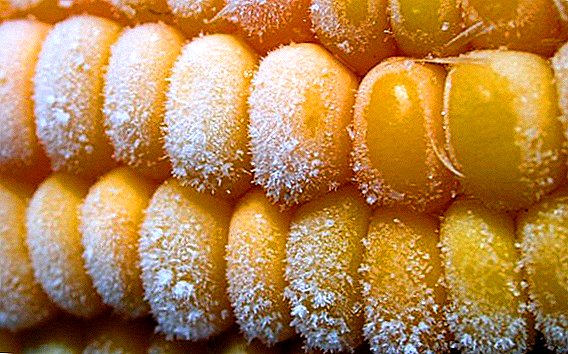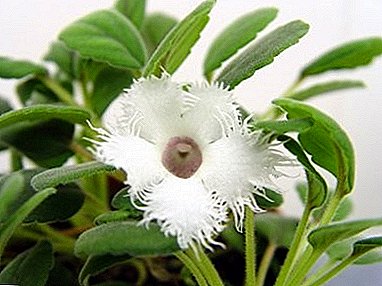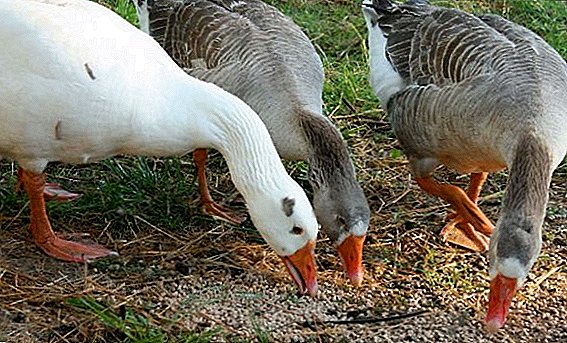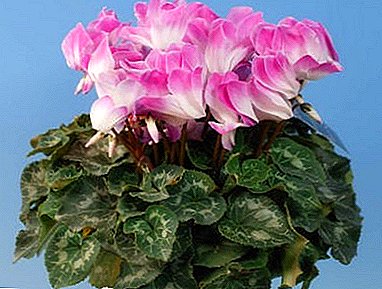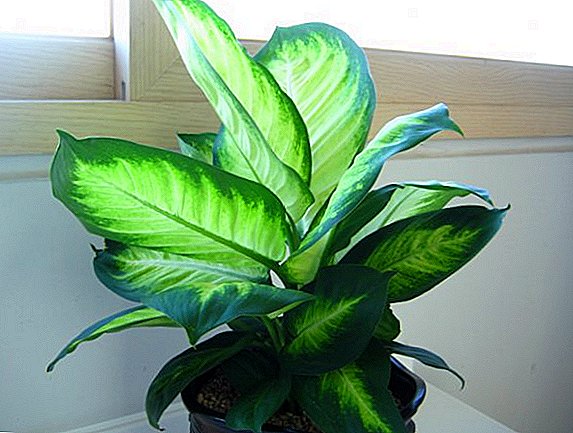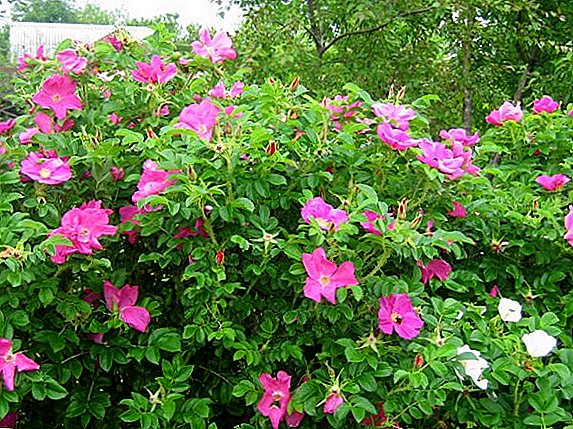 Among the many beautiful rose hips that exist in nature, the greatest popularity among gardeners has earned rose wrinkled, or roseroza, and its hybrids. The name "wrinkled" plant acquired thanks to shriveled leaves. Due to this characteristic, the shrub maintains a decorative appearance throughout the season, even after flowering, when the leaves become a beautiful reddish tint. And during the flowering and fruiting wrinkled rose appears in all its glory, so it is widely used in landscape design. However, in addition to high decorative qualities, this type of rosehip is also famous for other advantages: high cold resistance, the presence of healing properties and the ability to use petals in cooking. This article describes the main varieties of wild rose hips, as well as important features of its planting and care.
Among the many beautiful rose hips that exist in nature, the greatest popularity among gardeners has earned rose wrinkled, or roseroza, and its hybrids. The name "wrinkled" plant acquired thanks to shriveled leaves. Due to this characteristic, the shrub maintains a decorative appearance throughout the season, even after flowering, when the leaves become a beautiful reddish tint. And during the flowering and fruiting wrinkled rose appears in all its glory, so it is widely used in landscape design. However, in addition to high decorative qualities, this type of rosehip is also famous for other advantages: high cold resistance, the presence of healing properties and the ability to use petals in cooking. This article describes the main varieties of wild rose hips, as well as important features of its planting and care.
Did you know? Rosehip is one of the few plants that has stood the test of time. Scientists estimate that the age of a dog rose, growing in Germany, on the territory of Hildesheim Cathedral, ranges from 400 to 1000 years. The oldest specimen of Banks Brier, which is listed in the Guinness Book of Records and has been growing in the USA, Arizona, Tumstone, is more than 132 years old. Two similar specimens over 120 years old grow on the former dacha of the artist Korovin in Gurzuf (Crimea).
Rose wrinkled: description of the variety
 Rose wrinkled - This plant is a genus of rosehip, family Pink. Homeland plants - the Far East, China, Japan and Korea. It grows in thickets or in groups on sandy and pebble coasts and coastal meadows. The plant is a spreading shrub up to 2.5 m. It has strongly wrinkled leaves with a gray-green edge below, reaching 22 cm in length. Hybrid forms differ slightly shiny, glossy leaves. The thorns of the plant are numerous, curved down, reddish. Rosa rugosa has many varieties and hybrids that are similar in species description and differ in color and size of flowers. All varieties and hybrids have large, single, fragrant flowers from 6 to 12 cm in diameter, simple or terry. Plant blooms all summer, very plentiful - in June. Sometimes it blooms again, so it is often possible to observe both flowers and fruits on the same plant at the same time.
Rose wrinkled - This plant is a genus of rosehip, family Pink. Homeland plants - the Far East, China, Japan and Korea. It grows in thickets or in groups on sandy and pebble coasts and coastal meadows. The plant is a spreading shrub up to 2.5 m. It has strongly wrinkled leaves with a gray-green edge below, reaching 22 cm in length. Hybrid forms differ slightly shiny, glossy leaves. The thorns of the plant are numerous, curved down, reddish. Rosa rugosa has many varieties and hybrids that are similar in species description and differ in color and size of flowers. All varieties and hybrids have large, single, fragrant flowers from 6 to 12 cm in diameter, simple or terry. Plant blooms all summer, very plentiful - in June. Sometimes it blooms again, so it is often possible to observe both flowers and fruits on the same plant at the same time.
Important! Rosehip contains a lot of vitamin K, which affects blood clotting, so it is contraindicated for people suffering from grade III heart failure, endocarditis and thrombophlebitis.
The most spectacular and popular decorative wrinkled rosehip hybrids:
- F. Y. Grootendorst - has small (3-4 cm in diameter) terry, crimson-red flowers, with a slightly pronounced aroma. A characteristic feature of these flowers is an unusual clove form and abundant flowering until the end of the growing season. Because of this, the variety received the second name Nelkenrose, which from German means “clove rose”. The height of an erect bush reaches a meter and a half, and can be easily adjusted by trimming. The leaves of the plant are dark green, glossy. In mid-latitude conditions, the variety is very winter-hardy and does not require shelter, therefore, care for rosehips in the autumn involves only the removal of old leaves and mulching of young plants.
- Pink Grootendorst is one of the most amazing wrinkled roses. A plant up to one and a half meters high, pyramidal, sprawling form, leaves wrinkled, light green, glossy. The flowers are delicate, densely double, with a diameter of about 3-4 cm, a beautiful pink shade with carved edges of the petals, also very similar to carnations. These flowers look very beautiful among the bright greens in the garden. They bloom long and abundantly, in the autumn re-blooming is possible.

The Grootendorst Suprem varieties — with dark crimson-red flowers and the White Grootendorst — are pure white with the same virtues as the previous representatives of the Grootendorst series.
- Abelzieds - a tall pyramidal shrub, reaching a height of 2 meters. The flowers are cupped, pale pink, semi-double, up to 5-6 cm in diameter. Blossoms very plentiful and long. It has good winter hardiness.
- Agnes - large (7-8 cm in diameter) creamy yellow double flowers, darker towards the center. Very fragrant.
- George Ken - large, fragrant, semi-double flowers of dark red color.
- Konrad Ferdinand Meyer - very terry, bright, silvery-pink, fragrant flowers, with repeated flowering.
- My Hammerberg is a low-growing variety up to 50 cm high. The flowers are slightly double, light purple with a reddish tinge.
- The Queen of the North - the most winter-hardy variety with red, double flowers.
- Hanza - reddish-purple, large (up to 10 cm), double, very fragrant flowers.

Did you know? One of the main features of rose hips is the value of the healing properties of its fruits. They contain many vitamins B1, B2, B6, C, E, P. Rose hips often become a vitamin supplement or an ingredient in modern medical and cosmetic preparations. Rose hip also contains essential oil, the amount of which is not inferior to the Kazanluk rose.
Features planting wild rose: conditions for growing
Growing wrinkled roses will be a real pleasure for any florist, her planting and further care will not require significant effort.
Lighting
This is a very light-loving plant that prefers southern slopes or sunny even areas protected from strong gusts of wind.
Important! Wrinkled rose feels bad under the trees. If you plant it in the shade of trees, it will affect the flowering plants: lush, bright flowers can not be seen.
The soil
The plant is unpretentious and can grow on almost any soil, but most of all loves fertile and moist soils. It is important not to overdo it with fertilization in the soil.
Air temperature and humidity
Rose wrinkled grows well in mid-latitude, all its species have sufficient frost resistance to withstand frost without shelter for the winter. The plant is able to tolerate a slight drought in the summer.
How to plant a wrinkled rose, shrub reproduction
It is possible to propagate wild rose in the garden in three ways: by seed, by the root growth - by the offspring and by grafting. Seed method is ineffective, since its use splits the properties and characteristics of the parent plant. Therefore, we consider the two most convenient and efficient way.
Reproduction of the rose root shoots
Root growth for breeding can be prepared in two ways. The first is to dig up a scion 30-40 cm long in spring, cutting the root of the mother plant with a shovel at a distance of up to 25 cm from the scion. And the second way is not to dig up young growth, but to pile it up with a layer of humus 20-25 cm and water. Thus, adventitious roots will be formed on the heel of the shoot. In the fall of the second year, the roots of the mother bush should be trimmed with a spade together with the above-ground part, leaving up to 15 cm in height.
Growing wild rose from cuttings
 The second breeding method is the easiest and most popular, since any type of wild rose can be grown from green cuttings. Harvested planting material in late June - early July, when the intensity of the growth of shoots decreases. Green cuttings are cut from the uterine bushes with three nodes, removing the bottom leaf with a petiole. Sections are made near the knots with shears or a sharp knife. To make the cuttings better and faster to take root, you can hold them in the Heteroauxin solution at the rate of 200-300 mg per 1 liter of water or indolylbutyric acid (up to 100 mg per 1 liter). The cutting is immersed in the solution to a depth of 2.5 cm and incubated for about 20-24 hours.
The second breeding method is the easiest and most popular, since any type of wild rose can be grown from green cuttings. Harvested planting material in late June - early July, when the intensity of the growth of shoots decreases. Green cuttings are cut from the uterine bushes with three nodes, removing the bottom leaf with a petiole. Sections are made near the knots with shears or a sharp knife. To make the cuttings better and faster to take root, you can hold them in the Heteroauxin solution at the rate of 200-300 mg per 1 liter of water or indolylbutyric acid (up to 100 mg per 1 liter). The cutting is immersed in the solution to a depth of 2.5 cm and incubated for about 20-24 hours.
Before planting, mineral and organic fertilizers are applied in the soil: a mixture of peat or humus - 8-10 kg, with superphosphate 10 g and potassium salt 50 g per 1 square meter. m After preparation, planting material is planted in the substrate of coarse sand and lowland peat (3: 1). Seedlings are placed at a depth of 10-15 cm, keeping a distance of about one and a half meters from each other, according to the scheme 3 x 1.5 m. After planting, they watered abundantly, mulched and covered with foil. The above-ground part of the seedlings must be cut, leaving 1/3 of the length of the shoots.
Secrets of caring for a wrinkled rose in the garden
Rosehips are unpretentious plants, their planting and further care in the open ground are simple agrotechnical measures.
How often to water the plant
AT rooting of cuttings after planting, as well as for mature wrinkled rose plants, abundant watering is very important. At one bush is required to pour at least 10 liters of water. Watering is carried out about 3-4 times per season. If the bush is bearing fruit in conditions of a prolonged drought, watering should be increased.
Shrub fertilizer and soil care
 Rosehip wrinkled do not fertilize after planting: in the first two years, enough watering and standard care. In the third year in the spring, urea is applied at the rate of 15-20 g per 1 square meter. After the wrinkled rose begins to bear fruit, in the fall, once every 3-4 years, the plant is fed with organic (10-15 kg) and mineral fertilizers: 50-60 g of superphosphate and 20 g of potassium salt per 1 sq. m. After 6-7 years of active growth, the root system of the plant reaches a depth of up to 2.5 m, thanks to which the wild rose tolerates a short-lived drought. In order for the bush not to grow too much due to the root of the overgrowth, the plot with the plant must be insulated with vertically dug sheets of iron or other similar material. You also need to timely remove weeds and fallen leaves and loosen the soil surface.
Rosehip wrinkled do not fertilize after planting: in the first two years, enough watering and standard care. In the third year in the spring, urea is applied at the rate of 15-20 g per 1 square meter. After the wrinkled rose begins to bear fruit, in the fall, once every 3-4 years, the plant is fed with organic (10-15 kg) and mineral fertilizers: 50-60 g of superphosphate and 20 g of potassium salt per 1 sq. m. After 6-7 years of active growth, the root system of the plant reaches a depth of up to 2.5 m, thanks to which the wild rose tolerates a short-lived drought. In order for the bush not to grow too much due to the root of the overgrowth, the plot with the plant must be insulated with vertically dug sheets of iron or other similar material. You also need to timely remove weeds and fallen leaves and loosen the soil surface.
Pruning wrinkled rose
Caring for wild rose includes obligatory pruning of the bush - this is an important condition for good growth, flowering and fruiting plants. It is worth noting that this procedure is unpleasant, time consuming, but very necessary. The bush is not pruned for two years after planting. In the third year of vegetation, it is necessary to form a bush of 15-20 branches. To do this, remove all unnecessary branches: those that lie almost on the ground, as well as root offspring, which are far from the base of the bush. The remaining shoots should be cut at a height of 15-18 cm, leaving up to five well-developed young branches.  When the young shoots that appear on the stumps reach 70 cm in length, their tops are shortened by 1/5. This contributes to the growth of lateral shoots and stimulation of fruiting. Pruning wrinkled roses is recommended in the spring. In all subsequent years, pruning a plant will consist in the regular removal of weak, unproductive plants, old ones, as well as broken ones and underdeveloped ones. After the sixth year of the growing season, the number of branches must be regulated: no more than 16-20 branches at the age of 1 to 4 years old in a bush.
When the young shoots that appear on the stumps reach 70 cm in length, their tops are shortened by 1/5. This contributes to the growth of lateral shoots and stimulation of fruiting. Pruning wrinkled roses is recommended in the spring. In all subsequent years, pruning a plant will consist in the regular removal of weak, unproductive plants, old ones, as well as broken ones and underdeveloped ones. After the sixth year of the growing season, the number of branches must be regulated: no more than 16-20 branches at the age of 1 to 4 years old in a bush.
Plant resistance to diseases and pests
Wrinkled rose is highly resistant to diseases and pests. If you do not follow the recommendations on how to care for the hips (lack of light, fertilizer, moisture, nutrition, or vice versa, an overabundance), the plant weakens. In such conditions, the resistance of plants to many diseases and the colonization by pests is reduced. Most often, wrinkled rose is exposed to fungal diseases such as powdery mildew, rust, gray and brown rot. Of the pests, the plant can attack spider mites, leafworms and sawflies.  Therefore, in order for the wild rose to please its rich ornamental flowering for a long time, and only positive emotions bring about its cultivation and care, it is very important to follow the agrotechnical recommendations. If diseases and attacks of parasites could not be avoided, early spring will help, before kidney swelling, treatment with the insecticides Aktellik, Karbofos, Metiation, Rogor, etc. .
Therefore, in order for the wild rose to please its rich ornamental flowering for a long time, and only positive emotions bring about its cultivation and care, it is very important to follow the agrotechnical recommendations. If diseases and attacks of parasites could not be avoided, early spring will help, before kidney swelling, treatment with the insecticides Aktellik, Karbofos, Metiation, Rogor, etc. .


